Programing the Finite Element Method with
Matlab
Jack Chessa
∗
3rd October 2002
1 Introduction
The goal of this document is to give a very brief overview and direction
in the writing of finite element code using Matlab. It is assumed that the
reader has a basic familiarity with the theory of the finite element method,
and our attention will be mostly on the implementation. An example finite
element code for analyzing static linear elastic problems written in Matlab
is presented to illustrate how to program the finite element method. The
example program and supporting files are available at
http://www.tam.northwestern.edu/jfc795/Matlab/
1.1 Notation
For clarity we adopt the following notation in this paper; the bold italics font
v denotes a vector quantity of dimension equal to the spacial dimension of the
problem i.e. the displacement or velocity at a point, the bold non-italicized
font d denotes a vector or matrix which is of dimension of the number of
unknowns in the discrete system i.e. a system matrix like the stiffness matrix,
an uppercase subscript denotes a node number whereas a lowercase subscript
in general denotes a vector component along a Cartesian unit vector. So, if d
is the system vector of nodal unknowns, uI is a displacement vector of node I
and uIi is the component of the displacement at node I in the i direction, or
uI · ei. Often Matlab syntax will be intermixed with mathematical notation
∗Graduate Research Assistant, Northwestern University (j-chessa@northwestern.edu)
1
�
which hopefully adds clarity to the explanation. The typewriter font, font,
is used to indicate that Matlab syntax is being employed.
2 A Few Words on Writing Matlab Programs
The Matlab programming language is useful in illustrating how to program
the finite element method due to the fact it allows one to very quickly code
numerical methods and has a vast predefined mathematical library. This is
also due to the fact that matrix (sparse and dense), vector and many linear
algebra tools are already defined and the developer can focus entirely on
the implementation of the algorithm not defining these data structures. The
extensive mathematics and graphics functions further free the developer from
the drudgery of developing these functions themselves or finding equivalent
pre-existing libraries. A simple two dimensional finite element program in
Matlab need only be a few hundred lines of code whereas in Fortran or C++
one might need a few thousand.
Although the Matlab programming language is very complete with re-
spect to it’s mathematical functions there are a few finite element specific
tasks that are helpful to develop as separate functions. These have been
programed and are available at the previously mentioned web site.
As usual there is a trade off to this ease of development. Since Matlab
is an interpretive language; each line of code is interpreted by the Matlab
command line interpreter and executed sequentially at run time, the run
times can be much greater than that of compiled programming languages
like Fortran or C++. It should be noted that the built-in Matlab functions
are already compiled and are extremely efficient and should be used as much
as possible. Keeping this slow down due to the interpretive nature of Matlab
in mind, one programming construct that should be avoided at all costs is the
for loop, especially nested for loops since these can make a Matlab programs
run time orders of magnitude longer than may be needed. Often for loops
can be eliminated using Matlab’s vectorized addressing. For example, the
following Matlab code which sets the row and column of a matrix A to zero
and puts one on the diagonal
for i=1:size(A,2)
A(n,i)=0;
end
for i=1:size(A,1)
A(i,n)=0;
end
2
�
A(n,n)=1;
should never be used since the following code
A(:,n)=0;
A(:,n)=0;
A(n,n)=0;
does that same in three interpreted lines as opposed to nr +nc+1 interpreted
lines, where A is a nr×nc dimensional matrix. One can easily see that this can
quickly add significant overhead when dealing with large systems (as is often
the case with finite element codes). Sometimes for loops are unavoidable,
but it is surprising how few times this is the case. It is suggested that after
developing a Matlab program, one go back and see how/if they can eliminate
any of the for loops. With practice this will become second nature.
3 Sections of a Typical Finite Element Pro-
gram
A typical finite element program consists of the following sections
1. Preprocessing section
2. Processing section
3. Post-processing section
In the preprocessing section the data and structures that define the particular
problem statement are defined. These include the finite element discretiza-
tion, material properties, solution parameters etc. . The processing section is
where the finite element objects i.e. stiffness matrices, force vectors etc. are
computed, boundary conditions are enforced and the system is solved. The
post-processing section is where the results from the processing section are
analyzed. Here stresses may be calculated and data might be visualized. In
this document we will be primarily concerned with the processing section.
Many pre and post-processing operations are already programmed in Matlab
and are included in the online reference; if interested one can either look di-
rectly at the Matlab script files or type help ’function name’ at the Matlab
command line to get further information on how to use these functions.
3
�
4 Finite Element Data Structures in Matlab
Here we discuss the data structures used in the finite element method and
specifically those that are implemented in the example code. These are some-
what arbitrary in that one can imagine numerous ways to store the data for
a finite element program, but we attempt to use structures that are the most
flexible and conducive to Matlab. The design of these data structures may be
depend on the programming language used, but usually are not significantly
different than those outlined here.
4.1 Nodal Coordinate Matrix
Since we are programming the finite element method it is not unexpected that
we need some way of representing the element discretization of the domain.
To do so we define a set of nodes and a set of elements that connect these
nodes in some way. The node coordinates are stored in the nodal coordinate
matrix. This is simply a matrix of the nodal coordinates (imagine that).
The dimension of this matrix is nn × sdim where nn is the number of nodes
and sdim is the number of spacial dimensions of the problem. So, if we
consider a nodal coordinate matrix nodes the y-coordinate of the nth node is
nodes(n,2). Figure 1 shows a simple finite element discretization. For this
simple mesh the nodal coordinate matrix would be as follows:
.
0.0 0.0
2.0 0.0
0.0 3.0
2.0 3.0
0.0 6.0
2.0 6.0
nodes =
(1)
4.2 Element Connectivity Matrix
The element definitions are stored in the element connectivity matrix. This
is a matrix of node numbers where each row of the matrix contains the con-
nectivity of an element. So if we consider the connectivity matrix elements
that describes a mesh of 4-node quadrilaterals the 36th element is defined
by the connectivity vector elements(36,:) which for example may be [ 36
42 13 14] or that the elements connects nodes 36 → 42 → 13 → 14. So for
4
�
the simple mesh in Figure 1 the element connectivity matrix is
.
1 2 3
2 4 3
4 5 2
6 5 4
elements =
(2)
Note that the elements connectivities are all ordered in a counter-clockwise
fashion; if this is not done so some Jacobian’s will be negative and thus can
cause the stiffnesses matrix to be singular (and obviously wrong!!!).
4.3 Definition of Boundaries
In the finite element method boundary conditions are used to either form
force vectors (natural or Neumann boundary conditions) or to specify the
value of the unknown field on a boundary (essential or Dirichlet boundary
conditions). In either case a definition of the boundary is needed. The most
versatile way of accomplishing this is to keep a finite element discretization
of the necessary boundaries. The dimension of this mesh will be one order
less that the spacial dimension of the problem (i.e. a 2D boundary mesh for
a 3D problem, 1D boundary mesh for a 2D problem etc. ). Once again let’s
consider the simple mesh in Figure 1. Suppose we wish to apply a boundary
condition on the right edge of the mesh then the boundary mesh would be the
defined by the following element connectivity matrix of 2-node line elements
right Edge = 2 4
4 6 .
(3)
Note that the numbers in the boundary connectivity matrix refer to the same
node coordinate matrix as do the numbers in the connectivity matrix of the
interior elements. If we wish to apply an essential boundary conditions on
this edge we need a list of the node numbers on the edge. This can be easily
done in Matlab with the unique function.
nodesOnBoundary = unique(rightEdge);
This will set the vector nodesOnBoundary equal to [2 4 6].
If we wish to
from a force vector from a natural boundary condition on this edge we simply
loop over the elements and integrate the force on the edge just as we would
integrate any finite element operators on the domain interior i.e. the stiffness
matrix K.
5
�
4.4 Dof Mapping
Ultimately for all finite element programs we solve a linear algebraic system
of the form
Kd = f
(4)
for the vector d. The vector d contains the nodal unknowns for that define
the finite element approximation
uh(x) =
NI(x)dI
(5)
nn
I=1
where NI(x) are the finite element shape functions, dI are the nodal un-
knowns for the node I which may be scalar or vector quantities (if uh(x) is
a scalar or vector) and nn is the number of nodes in the discretization. For
scalar fields the location of the nodal unknowns in d is most obviously as
follows
dI = d(I),
(6)
but for vector fields the location of the nodal unknown dIi, where I refers to
the node number and i refers to the component of the vector nodal unknown
dI, there is some ambiguity. We need to define a mapping from the node
number and vector component to the index of the nodal unknown vector d.
This mapping can be written as
f : {I, i} → n
(7)
where f is the mapping, I is the node number, i is the component and n is
the index in d. So the location of unknown uIi in d is as follows
uIi = df (I,i).
(8)
There are two common mappings used. The first is to alternate between
each spacial component in the nodal unknown vector d. With this arrange-
ment the nodal unknown vector d is of the form
d =
(9)
u1x
u1y
...
u2x
u2y
...
unn x
unn y
...
6
�
where nn is again the number of nodes in the discretization. This mapping
is
n = sdim(I − 1) + i.
(10)
With this mapping the i component of the displacement at node I is located
as follows in d
dIi = d( sdim*(I-1) + i ).
(11)
The other option is to group all the like components of the nodal un-
knowns in a contiguous portion of d or as follows
u1x
u2x
...
unx
u1y
u2y
...
d =
The mapping in this case is
n = (i − 1)nn + I
(12)
(13)
So for this structure the i component of the displacement at node I is located
at in d
dIi = d( (i-1)*nn + I )
(14)
For reasons that will be appreciated when we discuss the scattering of element
operators into system operators we will adopt the latter dof mapping. It is
important to be comfortable with these mappings since it is an operation
that is performed regularly in any finite element code. Of course which ever
mapping is chosen the stiffness matrix and force vectors should have the same
structure.
5 Computation of Finite Element Operators
At the heart of the finite element program is the computation of finite element
operators. For example in a linear static code they would be the stiffness
matrix
K =
Ω
BT C B dΩ
(15)
7
�
and the external force vector
f ext =
Γt
Nt dΓ.
(16)
The global operators are evaluated by looping over the elements in the dis-
cretization, integrating the operator over the element and then to scatter the
local element operator into the global operator. This procedure is written
mathematically with the Assembly operator A
K = Ae
Ωe
BeT C Be dΩ
(17)
5.1 Quadrature
The integration of an element operator is performed with an appropriate
quadrature rule which depends on the element and the function being inte-
grated. In general a quadrature rule is as follows
ξ=1
ξ=−1
f (ξ)dξ =
q
f (ξq)Wq
(18)
where f (ξ) is the function to be integrated, ξq are the quadrature points and
Wq the quadrature weights. The function quadrature generates a vector of
quadrature points and a vector of quadrature weights for a quadrature rule.
The syntax of this function is as follows
[quadWeights,quadPoints] = quadrature(integrationOrder,
elementType,dimensionOfQuadrature);
so an example quadrature loop to integrate the function f = x3 on a trian-
gular element would be as follows
[qPt,qWt]=quadrature(3,’TRIANGULAR’,2);
for q=1:length(qWt)
xi = qPt(q); % quadrature point
% get the global coordinte x at the quadrature point xi
% and the Jacobian at the quadrature point, jac
...
f_int = f_int + x^3 * jac*qWt(q);
end
8
�
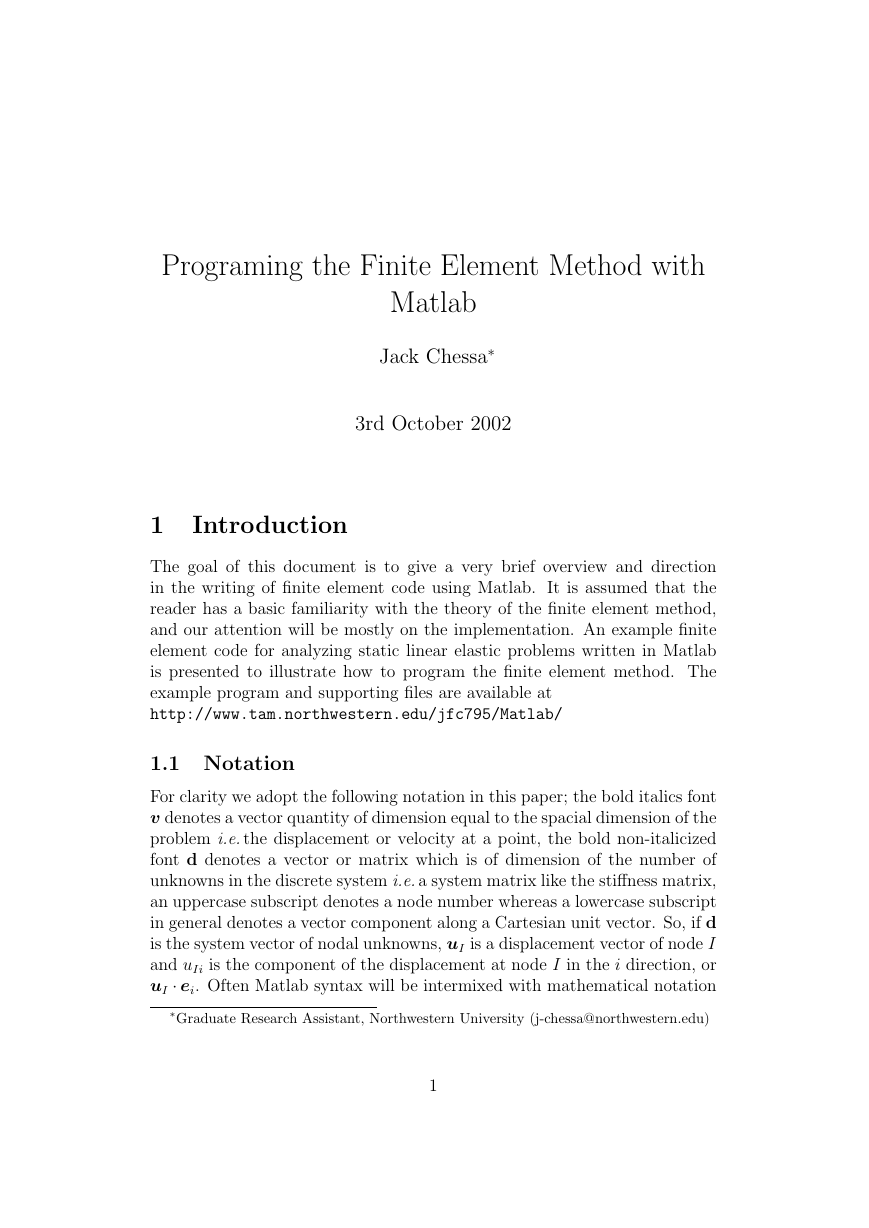
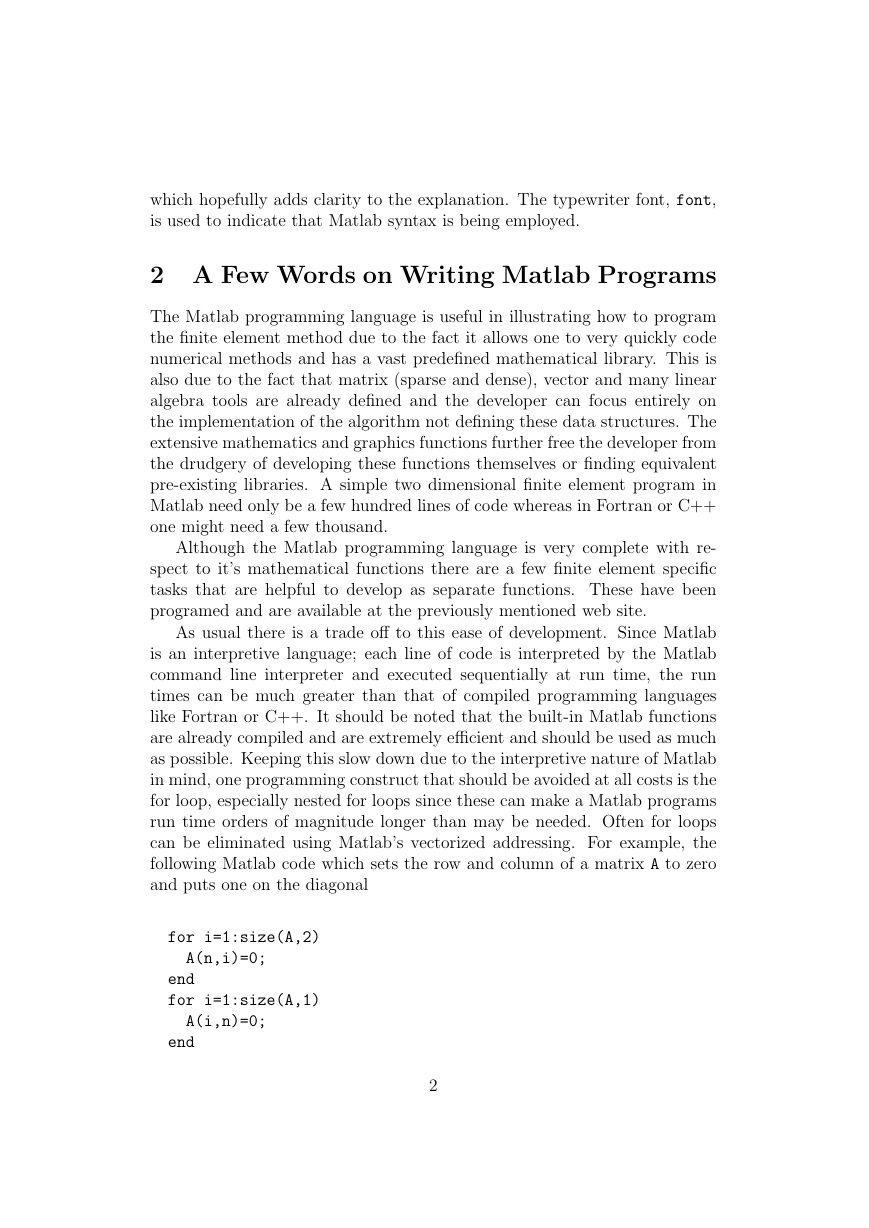
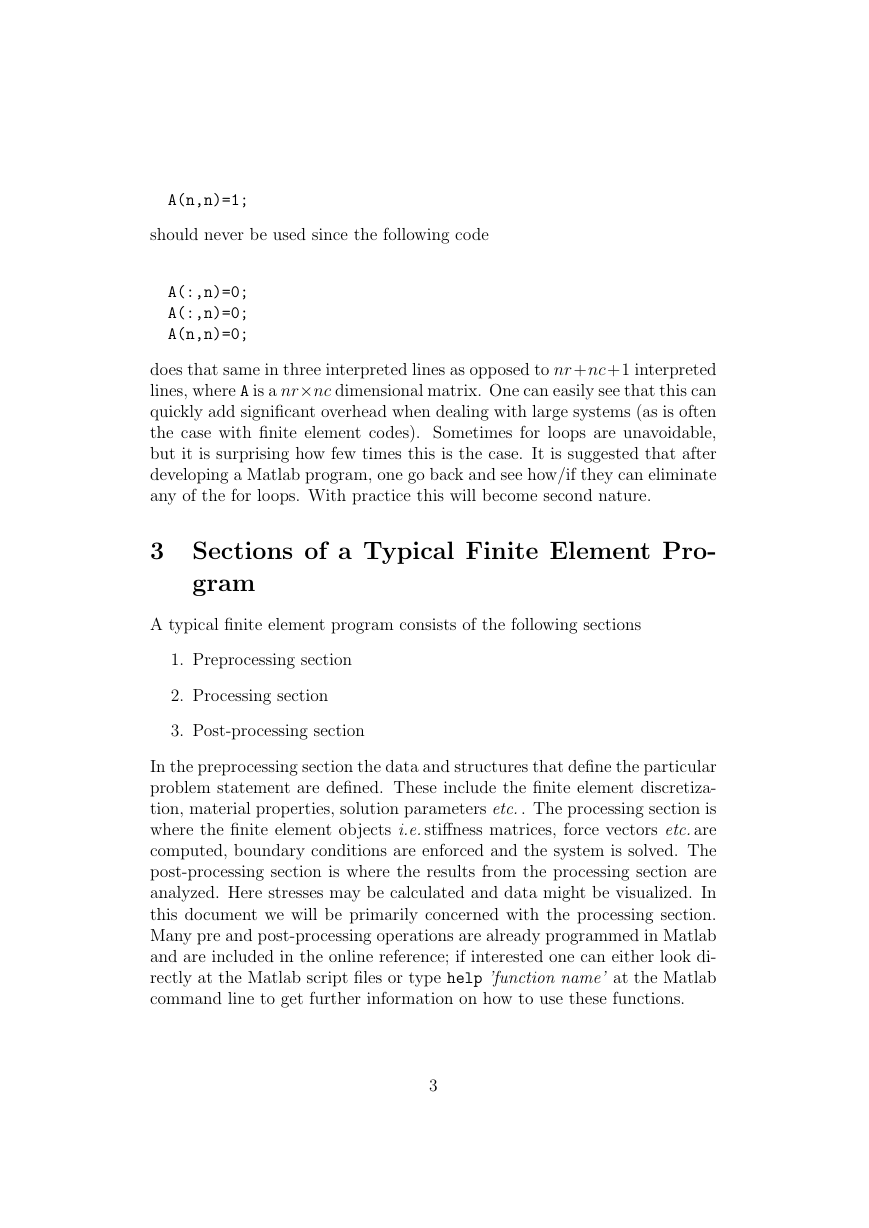

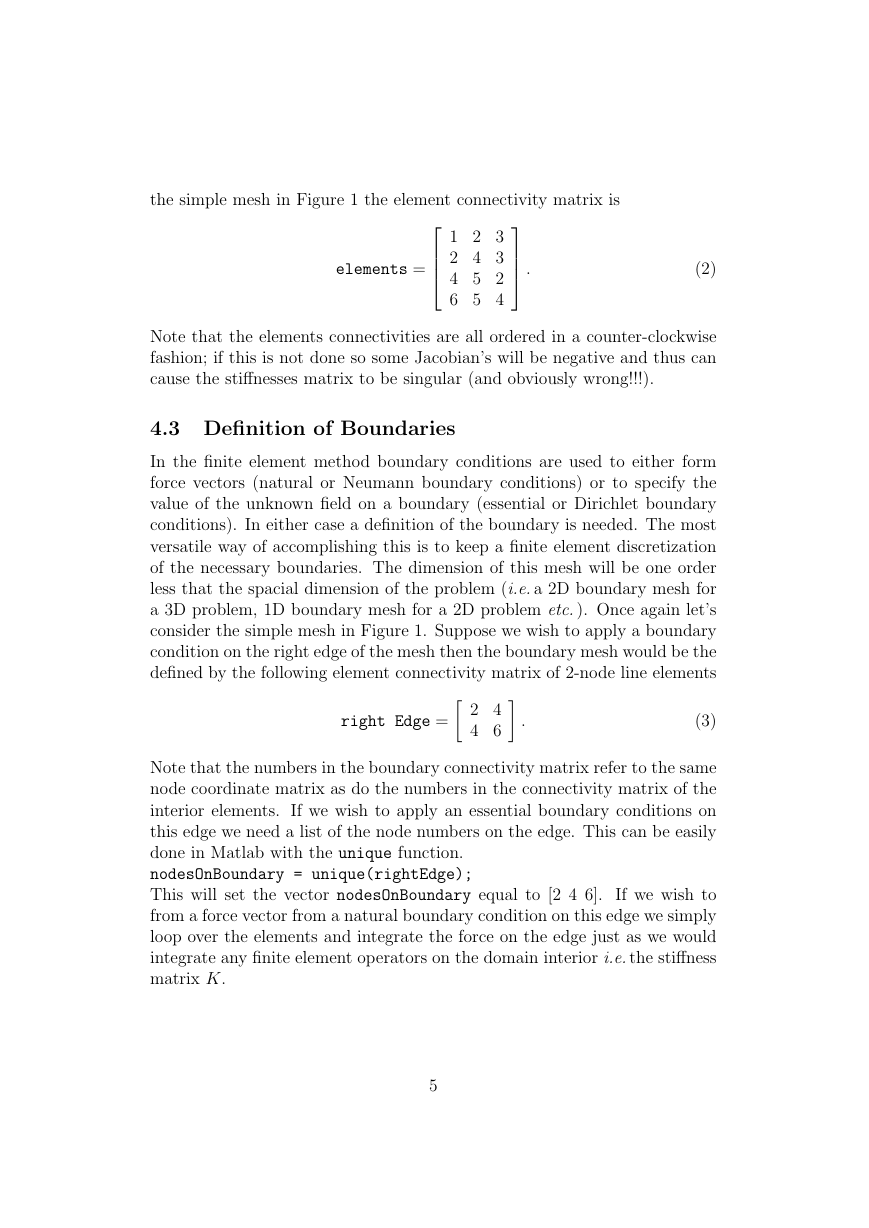
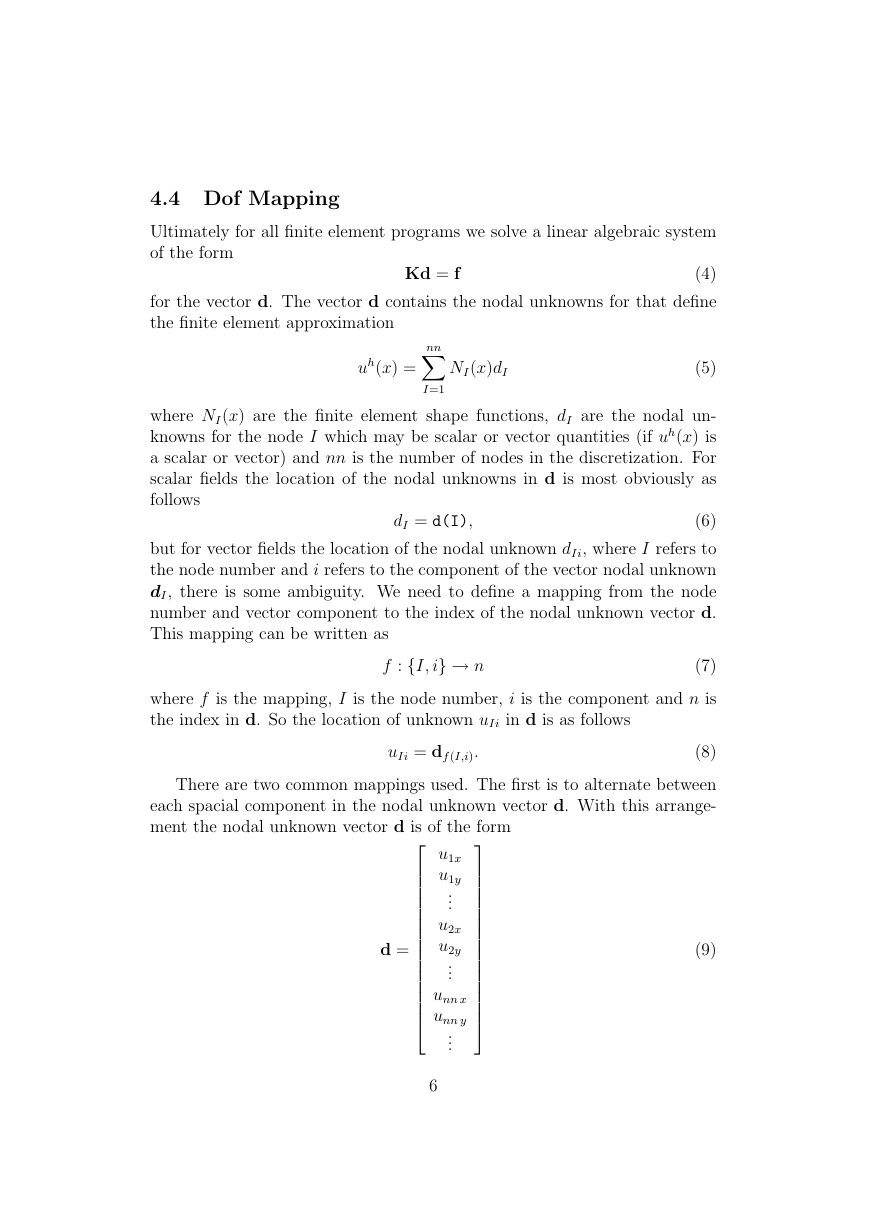
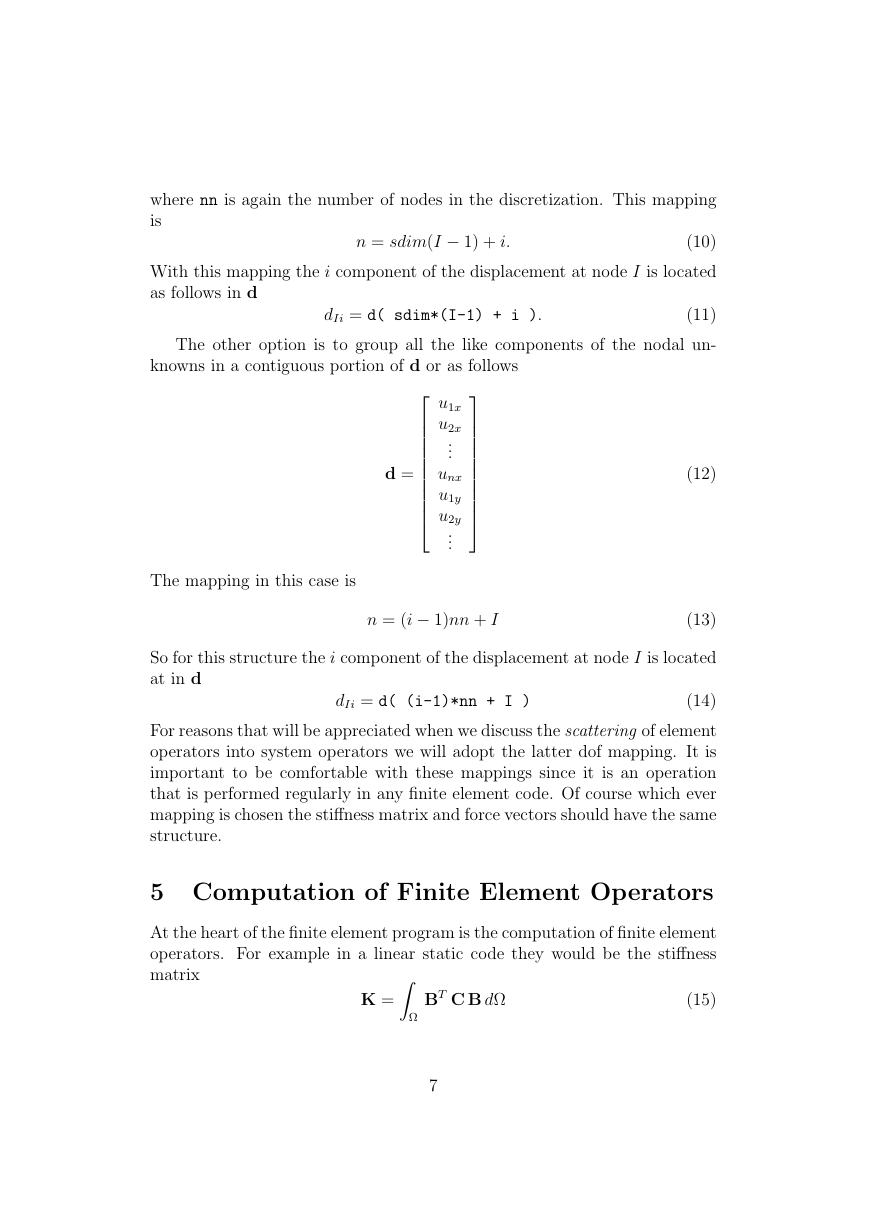
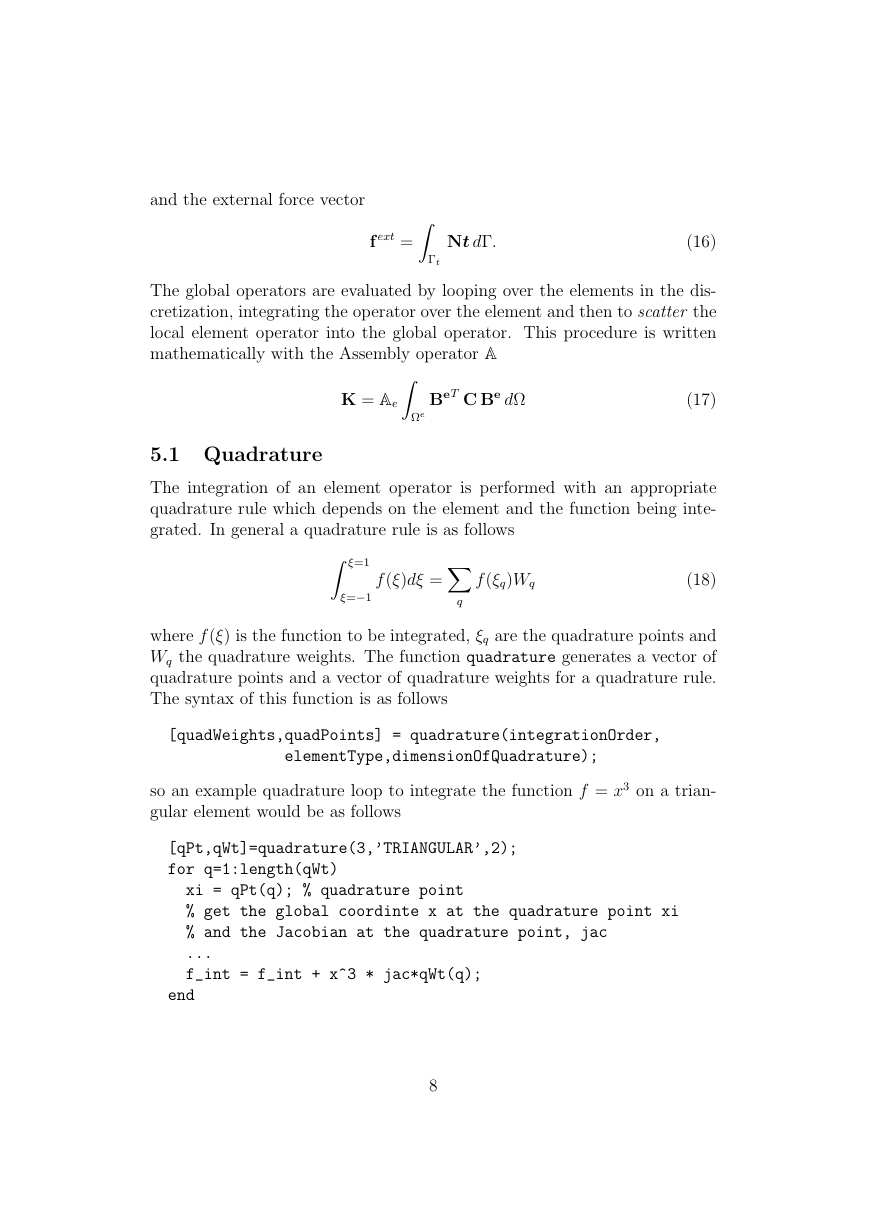








 2023年江西萍乡中考道德与法治真题及答案.doc
2023年江西萍乡中考道德与法治真题及答案.doc 2012年重庆南川中考生物真题及答案.doc
2012年重庆南川中考生物真题及答案.doc 2013年江西师范大学地理学综合及文艺理论基础考研真题.doc
2013年江西师范大学地理学综合及文艺理论基础考研真题.doc 2020年四川甘孜小升初语文真题及答案I卷.doc
2020年四川甘孜小升初语文真题及答案I卷.doc 2020年注册岩土工程师专业基础考试真题及答案.doc
2020年注册岩土工程师专业基础考试真题及答案.doc 2023-2024学年福建省厦门市九年级上学期数学月考试题及答案.doc
2023-2024学年福建省厦门市九年级上学期数学月考试题及答案.doc 2021-2022学年辽宁省沈阳市大东区九年级上学期语文期末试题及答案.doc
2021-2022学年辽宁省沈阳市大东区九年级上学期语文期末试题及答案.doc 2022-2023学年北京东城区初三第一学期物理期末试卷及答案.doc
2022-2023学年北京东城区初三第一学期物理期末试卷及答案.doc 2018上半年江西教师资格初中地理学科知识与教学能力真题及答案.doc
2018上半年江西教师资格初中地理学科知识与教学能力真题及答案.doc 2012年河北国家公务员申论考试真题及答案-省级.doc
2012年河北国家公务员申论考试真题及答案-省级.doc 2020-2021学年江苏省扬州市江都区邵樊片九年级上学期数学第一次质量检测试题及答案.doc
2020-2021学年江苏省扬州市江都区邵樊片九年级上学期数学第一次质量检测试题及答案.doc 2022下半年黑龙江教师资格证中学综合素质真题及答案.doc
2022下半年黑龙江教师资格证中学综合素质真题及答案.doc